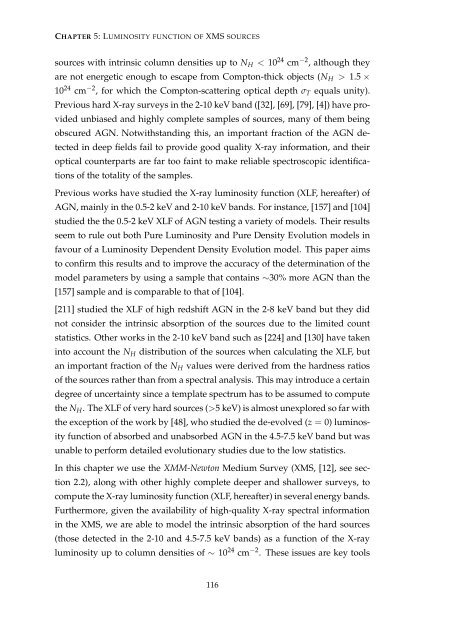pdf - SRON
pdf - SRON
pdf - SRON
Create successful ePaper yourself
Turn your PDF publications into a flip-book with our unique Google optimized e-Paper software.
CHAPTER 5: LUMINOSITY FUNCTION OF XMS SOURCES<br />
sources with intrinsic column densities up to N H < 10 24 cm −2 , although they<br />
are not energetic enough to escape from Compton-thick objects (N H > 1.5 ×<br />
10 24 cm −2 , for which the Compton-scattering optical depth σ T equals unity).<br />
Previous hard X-ray surveys in the 2-10 keV band ([32], [69], [79], [4]) have provided<br />
unbiased and highly complete samples of sources, many of them being<br />
obscured AGN. Notwithstanding this, an important fraction of the AGN detected<br />
in deep fields fail to provide good quality X-ray information, and their<br />
optical counterparts are far too faint to make reliable spectroscopic identifications<br />
of the totality of the samples.<br />
Previous works have studied the X-ray luminosity function (XLF, hereafter) of<br />
AGN, mainly in the 0.5-2 keV and 2-10 keV bands. For instance, [157] and [104]<br />
studied the the 0.5-2 keV XLF of AGN testing a variety of models. Their results<br />
seem to rule out both Pure Luminosity and Pure Density Evolution models in<br />
favour of a Luminosity Dependent Density Evolution model. This paper aims<br />
to confirm this results and to improve the accuracy of the determination of the<br />
model parameters by using a sample that contains ∼30% more AGN than the<br />
[157] sample and is comparable to that of [104].<br />
[211] studied the XLF of high redshift AGN in the 2-8 keV band but they did<br />
not consider the intrinsic absorption of the sources due to the limited count<br />
statistics. Other works in the 2-10 keV band such as [224] and [130] have taken<br />
into account the N H distribution of the sources when calculating the XLF, but<br />
an important fraction of the N H values were derived from the hardness ratios<br />
of the sources rather than from a spectral analysis. This may introduce a certain<br />
degree of uncertainty since a template spectrum has to be assumed to compute<br />
the N H . The XLF of very hard sources (>5 keV) is almost unexplored so far with<br />
the exception of the work by [48], who studied the de-evolved (z = 0) luminosity<br />
function of absorbed and unabsorbed AGN in the 4.5-7.5 keV band but was<br />
unable to perform detailed evolutionary studies due to the low statistics.<br />
In this chapter we use the XMM-Newton Medium Survey (XMS, [12], see section<br />
2.2), along with other highly complete deeper and shallower surveys, to<br />
compute the X-ray luminosity function (XLF, hereafter) in several energy bands.<br />
Furthermore, given the availability of high-quality X-ray spectral information<br />
in the XMS, we are able to model the intrinsic absorption of the hard sources<br />
(those detected in the 2-10 and 4.5-7.5 keV bands) as a function of the X-ray<br />
luminosity up to column densities of ∼ 10 24 cm −2 . These issues are key tools<br />
116
















